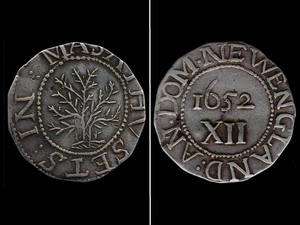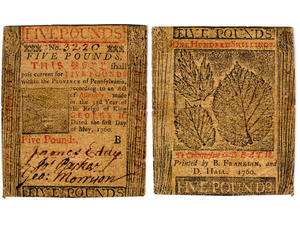The history of currency and counterfeiting in colonial America

Legitimate and counterfeit currency played a significant role in the Revolutionary War – either as a justification to start it or as part of a strategy to win it. However, to understand the economics of this time period, it is critical to know how colonial and counterfeit currency was produced, distributed, and utilized. To do this, new research at the University of Notre Dame will use historical data, the dates of production, and the composition of coins or the inks on paper currency to map out approximate geographic origins of the money, including counterfeit bills.
Notre Dame researchers, including both historians and scientists, will analyze more than 150 coins from colonial and early America, as well as approximately 550 pieces of paper currency currently held in the Hesburgh Libraries' Rare Books and Special Collections. Some of these coins date back to the first mint in Boston (1652), which was the colonies' first attempt to fight back against debased Spanish and Spanish-American silver currency, or coins that were lower in value than they were being traded for.
In explaining the research, Khachatur Manukyan, professor of physics and principal investigator on the project, said, "There is a theory that the first minted coins in the colonies actually used Spanish-American silver, just like Spanish-American coins. The thought is that the silver was melted down in Boston, a small amount of copper was added, and then the coins were distributed in Massachusetts. Since we don't know how counterfeit and legitimate coins differ in composition, we can only uncover the truth about them by using instruments that analyze the elemental composition and impurities of these centuries-old coins."
For example, historians know that Latin America was very rich in mineral resources, that mercury was used to recover silver from its ores in certain locations, and that the silver has lead and gold impurities. Therefore, by using non-invasive X-ray Fluorescent Spectroscopy and Particle Induced X-ray Emission method in Notre Dame's Nuclear Science Laboratory (NSL), scientists can determine the impurities in coins and more easily identify where the silver, as well as the coins, originated.

But colonial coinage isn't the only currency of interest to researchers. Paper currency was first introduced to the Western World as England was searching for a way to restrict the amount of silver in the colonies. However, after time, England also began imposing strict regulations on paper currency as it had with coins, which escalated tensions between England and the colonies.
"The colonists wanted the freedom to produce coins and paper currency to facilitate exchange and stimulate economic growth," said Louis Jordan, associate university librarian of academic services and collections. "However, the British government was still trying to maintain control so they heavily regulated production of all currency, which kept the colonies subservient to the needs of Britain. This added more fuel to the fire when it came to the colonies' push for independence."
At the beginning of the Revolutionary War, the United States Continental Congress authorized the printing of national currency to meet their expenses. While this did cause inflation, it is also believed that England introduced large amounts counterfeit currency to intensify the problem. Counterfeit paper currency had also been an issue before the war, so treasuries and printers were already regularly inventing new devices and printing methods in an effort to counteract fraudulent paper currency. In fact, Benjamin Franklin was one of the monetary printers who invented a method to fight back against counterfeiting before the war.
"The Hesburgh Library has paper currency from each of the 13 British colonies, including ones printed by Benjamin Franklin," said Manukyan. "Similar to how we are analyzing the composition of coins, we will also evaluate paper currency using instruments that we were used to characterize pigments in old, European manuscripts. In addition, we plan to develop these analytic approaches to reveal correlating patterns among geographic locations, date, and the composition of inks in paper currency, and compare the results with existing historical and numismatic literature. All these efforts will allow us to reveal the unknown history behind preparation of authentic and counterfeit currency."
This research will help develop a better historical understanding of not only where coins or paper monies were made, but also why certain elements – like unique printing or minting materials – were used.
Provided by University of Notre Dame




















